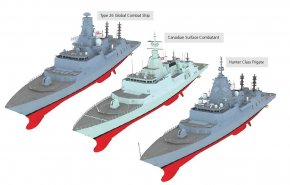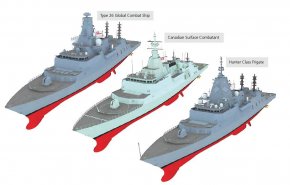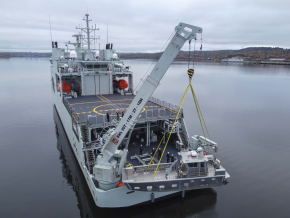I'm not sure if people noticed the pdf, but the diagram in the pdf version of the article also provides additional details. The article mentions torpedoes, but the diagram clarifies that the CSC will in fact have torpedo tubes as opposed to the base RN Type 26 which omits them. It's not clear though whether twin tubes means a total of 2 tubes per ship or 2 per side for a total of 4.
Whereas the article text generically describes the illuminator radar as solid-state, the diagram confirms it is AESA.
The diagram also indicates Long Range Precision Naval Fires Support is provided by the Mk41 VLS suggesting the RCN will actually adopt Tomahawk cruise missiles. Long range land strike is a more costly and offensive-minded capability than we're used to from Canadian defence policy.
Given ASW is still supposed to be CSC's major focus it's surprising there has yet to be any mention to date of VL-ASROC.
It's interesting that other than job postings to integrate SM-6 with CMS330 and SPY-7 for the CSC, official Lockheed Martin and Canadian government announcements have yet to confirm SM-6. That's probably for the best since they might as well prepare for SM-6 support, but wait for the new much larger SM-6 Block IB variant to finish development before buying SM-6. No sense in buying current SM-6 variants then having to pay to upgrade them soon after. It would probably be more cost effective to wait for the future active homing SM-2MR Block IIIC as well rather than buying the current SM-2MR Block IIIB as confirmed by Lockheed Martin, but I suppose they want to have a long range air defence missile available on commissioning rather than waiting.
This announcement also confirms the secondary guns are 30mm cannons which pictures and models have suggested are using MSI DS30M mounts with integrated EO/IR. I still think it would be better to use the Rafael Typhoon Mk-30c/BAE 30mm MGS mount to maximize commonality with the 25 mm Typhoon/Mk38 in the Harry DeWolf-class. Whereas the US FFG(X) program had a long list of government furnished or government specified equipment to maximize commonality with existing US equipment, the CSC process seems to give the design consortium a lot of freedom to select equipment as long as it meets the base performance/functional requirements. I suppose this helps keep the CSC build cost down, but seems to risk leaving the RCN with increased training and maintenance costs. Another example is the decoys/decoy launchers where the CSC models seem to consistently show BAE Mk36 SRBOC or similar fixed decoy launchers while an ongoing program is adding an additional Rheinmetall MASS trainable decoy launcher to the Halifax-class and models of the new Protecteur-class suggest it will be using MASS as well. It doesn't seem sensible for the CSC and Protecteur-class, which have overlapping lifespans, to use different decoys and decoy launchers, but that seems like what could happen since they have different project management offices and different design consortia.
It's also interesting that the CSC only has 1 Multi-Role Boat (MRB) unless the Mission Bay is used whereas the Halifax-class is currently undergoing an upgrade to provide 2 new MRBs per ship and the Harry DeWolf-class also carries 2 MRBs (as well as 2 larger boats).
Good find, but it actually looks like a 3x8cell displayed on the CSC - so only 24 cells but in a different arrangement than the RN model that has shown the 2x12 configuration for some time now. The Hunter has the 4x8 cell shown.
Would be a shame to build such a large, modern ship only to have a 24 cell MK 41.
It's strange that the digital/graphics models of the CSC pretty consistently show 24-cell Mk41 whereas the physical models in trade shows show 32-cell Mk41. With Euronaval 2020 being all digital I'm guessing a physical model hasn't been built so that we can't compare.
With an explicit goal for the CSC design to allow "re-rolling a deployed ship from one mission to another, without returning to port" that would be a lot easier to accomplish with 32-cells so that you can always carry a wide range of missiles.



